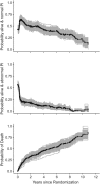Bootstrapping complex time-to-event data without individual patient data, with a view toward time-dependent exposures
- PMID: 31162707
- PMCID: PMC6771611
- DOI: 10.1002/sim.8177
Bootstrapping complex time-to-event data without individual patient data, with a view toward time-dependent exposures
Abstract
We consider nonparametric and semiparametric resampling of multistate event histories by simulating multistate trajectories from an empirical multivariate hazard measure. One advantage of our approach is that it does not necessarily require individual patient data, but may be based on published information. This is also attractive for both study planning and simulating realistic real-world event history data in general. The concept extends to left-truncation and right-censoring mechanisms, nondegenerate initial distributions, and nonproportional as well as non-Markov settings. A special focus is on its connection to simulating survival data with time-dependent covariates. For the case of qualitative time-dependent exposures, we demonstrate that our proposal gives a more natural interpretation of how such data evolve over the course of time than many of the competing approaches. The multistate perspective avoids any latent failure time structure and sampling spaces impossible in real life, whereas its parsimony follows the principle of Occam's razor. We also suggest empirical simulation as a novel bootstrap procedure to assess estimation uncertainty in the absence of individual patient data. This is not possible for established procedures such as Efron's bootstrap. A simulation study investigating the effect of liver functionality on survival in patients with liver cirrhosis serves as a proof of concept. Example code is provided.
Keywords: bootstrap; internal time-dependent covariates; joint model; simulation; survival analysis.
© 2019 The Authors. Statistics in Medicine Published by John Wiley & Sons Ltd.
Figures




References
-
- Burton A, Altman DG, Royston P, Holder RL. The design of simulation studies in medical statistics. Statist Med. 2006;25(24):4279‐4292. - PubMed
-
- Leemis LM. Variate generation for accelerated life and proportional hazards models. Operations Research. 1987;35(6):892‐894.
-
- Bender R, Augustin T, Blettner M. Generating survival times to simulate Cox proportional hazards models. Statist Med. 2005;24(11):1713‐1723. - PubMed
-
- Crowther MJ, Lambert PC. Simulating biologically plausible complex survival data. Statist Med. 2013;32(23):4118‐4134. - PubMed
-
- Wan F. Simulating survival data with predefined censoring rates for proportional hazards models. Statist Med. 2017;36(5):838‐854. - PubMed
Publication types
MeSH terms
LinkOut - more resources
Full Text Sources
